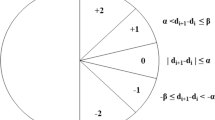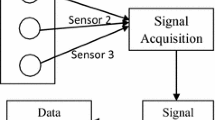Abstract
The fault diagnosis of a rotating multi-blade system has been conducted using the vibration characteristics of the system. For the fault diagnosis, multi-dimensional features related to the system vibration characteristics were extracted and used for monitoring the system health condition in most of previous studies. Recently, blade tip timing (BTT) method becomes increasingly popular to measure the vibration signals of rotating multi-blade systems. Due to the under-sampling characteristics of the method, relatively low frequency components of the vibration signal can be only collected with the BTT method. In this study, a statistical index called the Mahalanobis distance is defined and employed for the fault diagnosis of a rotating multi-blade system having a crack. The effects of crack existence and signal to noise ratio on the reliability of the proposed method using BTT signals obtained with a simulation model are investigated in this study.
Similar content being viewed by others
References
M. Ben-Daya, D. Ait-Kadi, S. O. Duffuaa, J. Knezevic and A. Raouf, Handbook of Maintenance Management and Engineering, Springer, London, UK, 7 (2009).
W. Sun, J. Chen and J. Li, Decision tree and PCA-based fault diagnosis of rotating machinery, Mechanical Systems and Signal Processing, 21 (2007) 1300–1317.
B. S. Yang, T. Han and W. W. Hwang, Fault diagnosis of rotating machinery based on multi-class support vector machines, Journal of Mechanical Science and Technology, 19(3) (2005) 846–859.
C. Angelakis, E. N. Loukis, A. D. Pouliezos and G. S. Stavrakakis, A neural network-based method for gas turbine blading fault diagnosis, International Journal of Modelling and Simulation, 21(1) (2001) 51–60.
W. K. Ngui, M. S. Leong, M. I. Shapiai and M. H. Lim, Blade fault diagnosis using artificial neural network, International Journal of Applied Engineering Research, 12(4) (2017) 519–526.
C. K. Choi, J. S. Kim and H. H. Yoo, Identification of location and size of a defect in a structural system employing active external excitation and hybrid feature vector components in HMM, Journal of Mechanical Science and Technology, 30(6) (2016) 2427–2433.
A. B. Andre, E. Beltrame and J. Wainer, A combination of support vector machine and k-nearest neighbors for machine fault detection, Applied Artificial Intelligence, 27 (2013) 36–49.
A. D. Dimarogonas, Vibration of cracked structures: a state of the art review, Engineering Fracture Mechanics, 55(5) (1996) 831–857.
P. C. Mahalanobis, On the generalized distance in statistics, Proceedings of the National Institute of Science of India, 12 (1936) 49–55.
G. Taguchi and R. Jugulum, The Mahalanobis-Taguchi Strategy: A Pattern Technology System, John Wiley and Sons, New York, USA (2002).
S. Kumar, T. W. S. Chow and M. Pecht, Approach to fault identification for electronic products using Mahalanobis distance, IEEE Transactions on Instrumentation and Measurement, 59(8) (2010) 2055–2064.
X. Jin and T. W. S. Chow, Anomaly detection of cooling fan and fault classification of induction motor using Mahalanobis-Taguchi system, Expert Systems with Applications, 40 (2013) 5787–5795.
J. Lin and Q. Chen, Fault diagnosis of rolling bearings based on multifractal detrended fluctuation analysis and Mahalanobis distance criterion, Mechanical Systems and Signal Processings, 38 (2013) 515–533.
G. Dimitriadis, I. B. Carrington, J. R. Wright and J. E. Cooper, Blade-tip timing measurement of synchronous vibrations of rotating bladed assemblies, Mechanical Systems and Signal Processing, 16(4) (2002) 599–622.
P. Beauseroy and R. Lengellé, Nonintrusive turbomachine blade vibration measurement system, Mechanical Systems and Signal Processings, 21(4) (2007) 1717–1738.
H. H. Yoo, R. R. Ryan and R. A. Scott, Dynamics of flexible beams undergoing overall motion, Journal of Sound and Vibration, 181(2) (1995) 261–278.
H. H. Yoo and S. H. Shin, Vibration analysis of rotating cantilever beams, Journal of Sound and Vibration, 212(5) (1998) 807–828.
Y. T. Oh and H. H. Yoo, Vibration analysis of a rotating pretwisted blade considering the coupling effects of stretching, bending and torsion, Journal of Sound and Vibration, 431 (2018) 20–39.
H. H. Kim, Y. T. Oh and H. H. Yoo, Simple vibration model for the design of a vertical axis wind turbine, Journal of Mechanical Science and Technology, 34(2) (2020) 511–520.
M. H. F. Dado and O. Abuzeid, Coupled transverse and axial vibratory behavior of cracked beam with end mass and rotary inertia, Journal of Sound and Vibration, 261 (2003) 675–696.
T. R. Kane and D. A. Levinson, Dynamics, Theory and Applications, McGraw Hill, New York, USA (1985).
K. S. Kannan and K. Manoj, Outlier detection in multivariate data, Applied Mathematical Sciences, 47 (2015) 2317–2314.
P. Galeano, E. Joseph and R. E. Lillo, The Mahalanobis distance for functional data with applications to classification, Technometrics, 57(2) (2015) 281–291.
M. Zhang and R. Schmidt, Sensitivity analysis of an autocorrelation-function-based damage index and its application in structural damage detection, Journal of Sound and Vibration, 333(26) (2014) 7352–7363.
J. H. Kuang and B. W. Huang, The effect of blade crack on mode localization in rotating bladed disks, Journal of Sound and Vibration, 227(1) (1999) 85–103.
Acknowledgments
This research was supported by the Basic Science Research Program through a grant from the National Research Foundation of Korea (NRF) funded by the Ministry of Science, ICT (NRF-2018R1A2A2A05022590).
Author information
Authors and Affiliations
Corresponding author
Additional information
Recommended by Editor No-cheol Park
Jae Phil Chung received his B.S. degree in the Department of Mechanical Engineering in Hanyang University in 2018. He is working as a M.S. candidate in the Department of Mechanical Convergence Engineering in Hanyang University, Seoul, Korea. His research interests include structural vibration and dynamics.
Hong Hee Yoo received his B.S. and M.S. degrees in the Department of Mechanical Design in Seoul National University in 1980 and 1982. He received his Ph.D. degree in the Department of Mechanical Engineering and Applied Mechanics in the University of Michigan at Ann Arbor in 1989. He is a Professor in the Department of Mechanical Engineering at Hanyang University, Seoul, Korea. His research interests include multi-body dynamics, structural vibration and statistical uncertainty analysis in mechanics.
Rights and permissions
About this article
Cite this article
Chung, J.P., Yoo, H.H. Blade fault diagnosis using Mahalanobis distance. J Mech Sci Technol 35, 1377–1385 (2021). https://doi.org/10.1007/s12206-021-0304-y
Received:
Revised:
Accepted:
Published:
Issue Date:
DOI: https://doi.org/10.1007/s12206-021-0304-y




